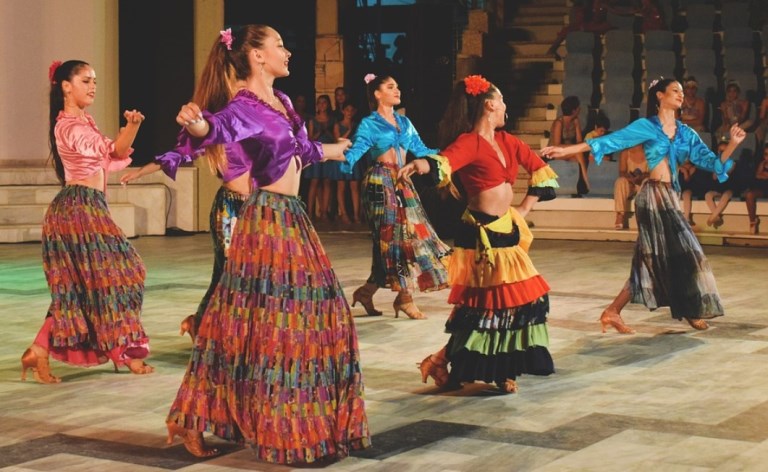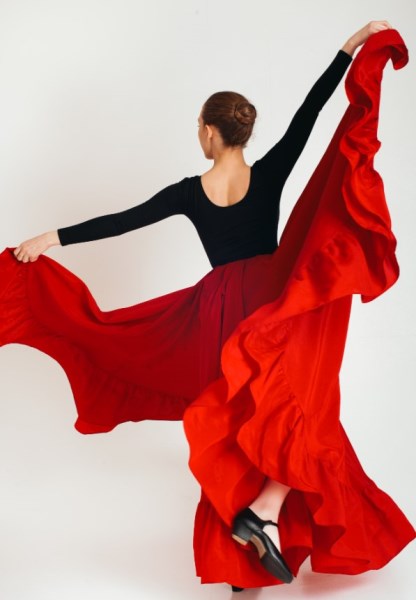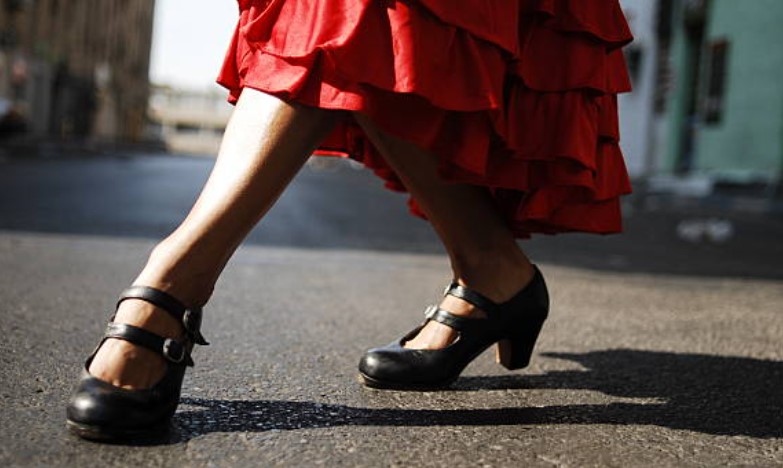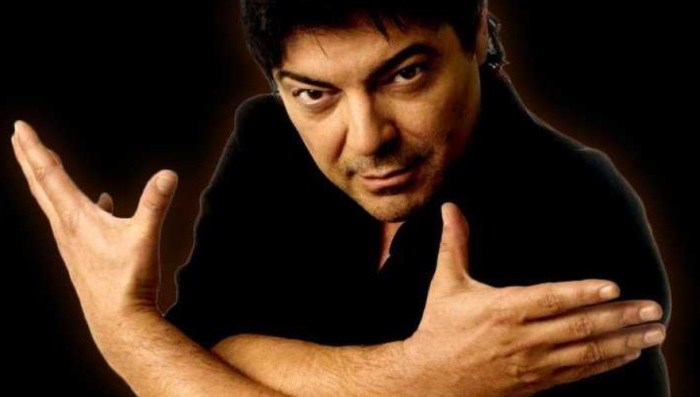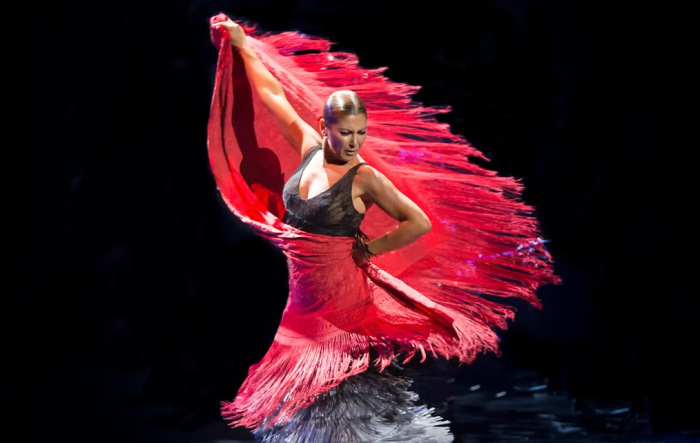Flamenco dance is amongst the highlights of traditional Spanish dances. It originated in the region back in the 19th century.
Today, it is still a beloved dance that’s enjoyed informally at clubs and gathering professional Latin dance competitions around the world.
But have you ever wondered about the origins of all these dynamic and energetic dance moves, colorful costumes, and enchanting music?
That’s what we’ll set out to explore in today’s article!
Table of Contents
What Is Flamenco Dance?
Flamenco dance (baile) is a Spanish dance that originated in the Andalusian region of Southern Spain.
In it, the dancer, known as bailaor or bailaora, performs a series of intricate dances (composed of hand clapping, percussive footwork, and intricate hand, arm), and body movements to the music set by a singer (cantaor) and guitar player (tocoar).
The most distinguishing feature of the flamenco is the hand and finger movements (called florea). They help the dancer with conveying emotions and lend an element of storytelling to the routine.
The percussive footwork, known as “zapateado,” adds another dimension of rhythmic complexity to the dance.
Besides florea and zapateado, there are also many other elements to the flamenco such as heelwork (taconeo) and arm movements (braceo). All of which – with some learnings – you can easily distinguish and recognize.
Flamenco Dance Origin & History
Early History
Flamenco dance is a dance with Spanish roots.
According to dance historians, the earliest traces of the dance were in the late 18th century in the rural town of Baja Andalusia.
But, at this time, the flamenco dance was indistinguishable from other schools of the bolero dance (this is one of the most interesting flamenco dance facts!).

Later History
The golden age of flamenco is usually considered the period between roughly 1780 and 1845.
Back during this period, flamenco was mostly known through singing and its music rather than dancing. This plays a secondary role in a performance.
But this order was changed in 1842 when Silverio Franconetti established the first café cantante, Café sin Nombre, in Sevilla (Seville). In the café, cantaor (flamenco singers) compete with one another to give performances to patrons.
However, over time, the patrons developed a newer taste. Instead of the singers, they began to favor dancers better.
Eventually, by the end of the century, singers have been relegated to a background position, while dancers literally stake the stage front and center.
While these venues provided opportunities for performers to earn a living, they also brought criticism for potentially diluting the authenticity of the art form.
To restore the purity of flamenco, intellectuals like Lorca and composer Manuel de Falla took action in 1922 by organizing the first flamenco competition.
This competition sought to promote cante primitivo Andaluz (“primitive Andalusian cante”). Supposedly, it’s also to help preserve the vestiges of old Andalusian folk arts.
And the effort succeeded!
These competitions successfully attracted a sophisticated urban audience and encouraged the development of flamenco from folk art to a higher, more modern art form.
During the early 20th century, flamenco once more went through another heyday period.
Many legendary performers took to the stage during the century, such as La Argentina (Antonia Mercé), Vicente Escudero, Carmen Amaya, La Argentinita (Encarnación López), José Greco, Pilar López.
There were also many famous flamenco troupes such as Antonio and Rosario (Antonio Ruiz Soler and Rosario Florencia Pérez Podilla) and Ximénez-Vargas (Roberto Ximénez and Manolo Vargas).
Influenced by classical styles, artists like Antonio Gades, Christina Hoyos, José Greco II, and Lola Greco expanded the boundaries of flamenco.
Gades successfully introduced flamenco to an international audience outside of Spain, particularly through his collaborations with filmmaker Carlos Saura.
Contemporary Era
In the contemporary era, flamenco dance is represented by artists such as Eva la Yerbabuena, Joaquín Cortés, Antonio Canales, Belén Maya, and Juana Amaya. They have continued to push the boundaries of flamenco.
They experiment with new rhythmic strategies in the studio and integrate them into longer narrative theater pieces, where rhythm becomes a dominant element of the dance.
Additionally, flamenco has been influenced by the broader musical trend of fusion, leading to innovative collaborations and the incorporation of diverse styles.
Basic Flamenco Steps
Basic Flamenco Steps
Flamenco is a fairly complex dance. As such, don’t be discouraged if you don’t “get it” on day one.
With persistence, a good practice schedule, and maybe even a good instructor, you’ll be able to learn the basic steps in a week or two.
Here are a few basic steps you can try out at home or the studio to drill yourself.
- Start with your dominant foot
Although you need to master the basic movements on both feet to perform flamenco, for beginners, it’s best to start with whichever foot that’s dominant.
- Create five sounds
Remember to create five distinct sounds as you perform each sequence step.
- Toe: Tap your toe down and let it stay on the ground, and make a click.
- Heel: Tap your heel down, making a second click.
- Heel: Tap down your heel again and keep it on the floor for a third click.
- Toe: Tap your toe down and let it stay there, ensuring it remains touching the floor while performing your heel taps, making a fourth click.
- Flat: And lastly, your entire foot should touch the floor. Raise it and perform a flat or stamp. This is the fifth click.
- Switch to the other foot
Once you feel confident with your dominant foot, switch to your other foot and repeat the sequence of steps.
- Practice for perfection
And that’s the basic step sequence!
Practice the entire sequence of steps, “Toe – Heel – Heel – Toe – Flat”, with both feet until you have perfected it.
Taking it slow and paying attention to the techniques will come a long way in helping you master the flamenco.
How To Perform A Backswing
During a performance, you may see a flamenco dancer swinging one of their feet backward. This is called a backswing. And it’s one of the reasons why flamenco gets the reputation of being very lively and energetic.
A backswing is fairly simple to do and can be blended with the basic steps to liven it up.
- Get into position.
- Keep your knees close together.
- Lift one foot behind you so that the lower leg forms a right angle with the upper leg.
Professionals may shorten the backswing during fast zapateado. However, for beginners who aren’t used to the motion just yet, take it slow.
How To Perform A Dig
A “dig” is when the foot strikes or “digs” into the floor and makes a thudding sound. There are two kinds of digs: one that’s done on the ball of the foot, and one that’s done with the heel (talon).
To perform a dig with the ball of the foot:
- Perform a backswing.
- Allow your foot to drop with gravity.
- Let the ball of your foot strike the floor with a resounding thud.
And for performing the dig with the heel of the foot:
- Use the same technique as the ball of the foot dig.
- However, you don’t have to raise your toes. Instead, keep the foot only slightly angled.
Ideally, the spectators shouldn’t see the difference between a dig with the ball of the foot versus one that’s done with the heel. Only the sound quality of the thud (dryer when done with the heel) should be different.
Flamenco Dancer Costume
Even more striking than their dance movements is the flamenco costume.
Female Costume
There are two costume variations for female dancers: traje de flamenca and traje de gitana.
Both versions of the dress are adorned with layers of ruffles on the skirt and sleeves, adding a dynamic visual element.
The flamenco dress is typically brightly colored, with popular choices being black, red, or patterned designs. The traje de lunares, featuring polka dots, is particularly famous.
Completing the outfit is a shawl called the mantón de Manila, which is elegantly draped over the shoulders.
Traditional dancers often style their hair in a bun adorned with flowers and may include decorative hair combs.
Male Costume
Male dancers’ flamenco dance attires are much more limited than their female counterparts. They usually wear a simple shirt underneath a vest.
Completing the look would be a pair of tight-fitting trousers. Accessory-wise, they’ll wear a scarf around their necks.
Flamenco Dance Shoes
There are specialized dance shoes that professional flamenco dancer wears.
These are typically handmade, crafted from premium, comfy, and durable materials like leather with nails in the sole of the toe and heel.
For beginners, a good pair of cheap flamenco dance shoes with rubber heels will do the trick.
Flamenco Dance Music
Flamenco music is characterized by three fundamental elements.
The first element is the presence of a flamenco mode or musical tonality. This mode sets the distinct melodic framework for the music and contributes to its unique sound.
The second element is the compás, which refers to the rhythmic structure of flamenco. It provides a rhythmic foundation for the music.
Finally, the final piece is a flamenco performer’s interpretation, passion, and mastery of the music. They’re the ones that hold the key to flamenco’s expressive power.
But that’s not all.
Many musicians also include a fourth element in flamenco, called flamencura.
It’s hard to define what flamencura really is because it’s only loosely described as “the quality that captures the essence and soul of flamenco”. Basically, it’s the emotional power that the music has over the audience.
Flamenco music is not a passive experience for the audience. It is participatory in nature, and spectators often engage by clapping their hands and sometimes even singing along.
This is one of the key reasons why flamenco music (as well as dance) is still popular today in many communities!
Famous Flamenco Dancers
Over the years, there have been many great dancers ranging from great to legendary. Here are a few names worth checking out.
Carmen Amaya
Carmen Amaya, the legendary flamenco dancer, was born in Barcelona, Spain, on November 2nd, around 1913 or 1915. Guided by her father, a guitarist known as “El Chino”, Carmen immersed herself in the world of flamenco.
Her talent blossomed, leading to performances in small theaters and later prestigious venues like the Palace Theatre in Paris.
Carmen’s unique style fused traditional and modern flamenco. She became the first female dancer to master advanced, fast-tempo moves typically reserved for men.
Her illustrious career tragically ended in 1963 when she passed away in Begur, Spain.
Antonio Gades
Antonio Gades, born Antonio Esteve Ródenas on November 14th, 1936, was a renowned Spanish flamenco dancer. He played a vital role in popularizing flamenco beyond Spain’s borders.
With a deep respect for tradition, Gades studied Spanish customs and traditions to restore the authentic essence of flamenco.
Unlike many contemporaries at the time, Gades prioritized maintaining the art’s integrity rather than conforming to modern trends.
Gades’s significant contribution was transforming flamenco into a captivating form of dramatic art.
Notable among his works are dance adaptations of Carmen by Prosper Mérimée and Blood Wedding by Federico García Lorca. He also appeared in Manuel de Falla’s ballet El Amor Brujo.
Antonio passed away from cancer in Madrid on July 20th, 2004.
Antonio Canales
Antonio Canales, born Antonio Gómez de los Reyes on December 3rd, 1961, is a renowned male flamenco dancer who rose to fame in the 80s and 90s.
Born in Seville, Spain, Antonio began his dance journey at a young age, honing his skills at the Spanish National Ballet.
At just 20 years old, he became a solo dancer for the prestigious Spanish National Ballet, under the guidance of acclaimed choreographer and dancer Victor Ullate.
As a modernist, he pushed boundaries, introducing new moves while preserving the classical essence of flamenco. His innovative approach resulted in many unique variations of flamenco to form!
Sara Baras
Sara Baras, renowned as one of the finest contemporary flamenco artists, was born in San Fernando, Spain, on April 25th, 1971.
Her journey began in her mother’s dance school, Concha Baras, where she honed her skills.
Joining Los Niños de la Tertulia Flamenca, she toured flamenco festivals in Barcelona, marking a pivotal moment in her career.
Sara’s talent propelled her to perform with various companies, gaining recognition and numerous accolades.
Notably, she received the esteemed Medal of Cadix province in 2015 and the APDE prize in 2010, acknowledging her significant contributions to dance education.
Flamenco Glossary
Much like ballet, many technical terms are used in flamenco to describe a variety of skills, moves, and concepts. Here are 10 popular terms that you’ll need to learn as a beginner:
- Compás: The rhythmic pattern or beat in flamenco music and dance.
- Palmas: Hand-clapping rhythms that accompany flamenco music and dance.
- Cante: The singing aspect of flamenco, characterized by passionate and emotional vocal expressions.
- Zapateado: The fast footwork and tapping technique in flamenco dance.
- Bulerías: A lively and festive flamenco music and dance style characterized by its complex rhythm and improvisation.
- Guitarra: The flamenco guitar, a key instrument in flamenco music, is known for its unique techniques and rich sound.
- Falseta: A melodic or rhythmic phrase played on the flamenco guitar, often used as a solo or improvisation.
- Estilo: A specific flamenco style, such as Soleá, Tangos, or Alegrias, each with its own distinct rhythm, melody, and character.
- Jaleo: Vocal encouragement and shouts of support from the audience during a flamenco performance.
- Llamada: A call or signal is given by one dancer or musician to cue a specific movement or change in the performance.
Final Words
From its agrarian roots in the 18th century to the urban centers of the 21st century, the flamenco dance still hasn’t gone out of style and is still loved by many today.
We hope this article has given you a better idea of flamenco’s roots as an art form, and maybe even inspire you to take the first step into the wonderful dance!
